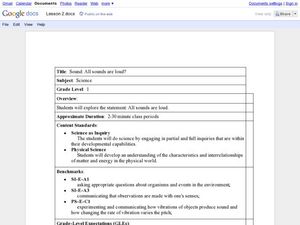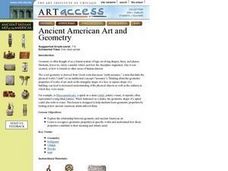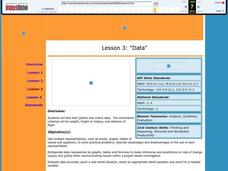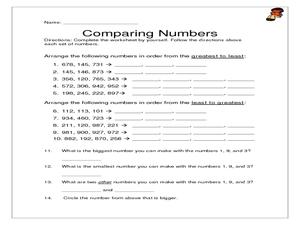Curated OER
Sound: Are All Sounds Loud?
First graders explore physics by utilizing education software. In this sound properties lesson, 1st graders discuss the different sounds associated with different materials and perform an object dropping experiment in class. Students...
Curated OER
The President’s Cabinet
In this presidential cabinet worksheet, students read the 15 descriptions of Cabinet positions and match them to the appropriate titles.
Curated OER
Alphabet Sideshow
Students practice sound and recognition of letters in alphabetical sequence. They gain an understanding of letter sounds and order. They create a slide show with graphics and text. They present their slide show to the class.
Curated OER
Proving Quadrilateral Properties
Working backwards can sometimes help you see a path to solving a problem. In this chapter, properites of quadrilaterials are proven by looking at flowcharts and working the probem backwards. Worked through examples are given, along with...
Curated OER
Protective Design
Over 3 or 4 class periods your young designers will create a wearable garment that provides some sort of protection from a danger in everyday life. In this fashion design instructional activity, students investigate fear in our society...
Curated OER
Ancient American Art and Geometry
Students explore the relationship between geometry and ancient American art. They see how to recognize geometric properties in specific works and explain how these properties contribute to their meaning and artistic merit.
Curated OER
Campaign Signs and Pranksters
Students collect campaign literature and investigate what signs local candidates are using. Students contact local politicians/candidates and interview them about the concepts and creation of their campaign literature. Students compare...
Curated OER
Cell Game
Make a prototype of a game based on cell biology. Researching game design and working in groups to create a game will activate knowledge of cell biology. The review task will help students learning as they test out the games and their...
Utah Education Network (UEN)
It's All Just Similar to Me
Middle schoolers explore the concept of similar figures. In this similar figures lesson, pupils calculate scale factors of similar triangles. They find missing sides of triangles, and measure angles using protractors and measure sides of...
Curated OER
Data
Students collect data from an experiment they perform. In this data lesson, students use multiple representations to solve practical problems; describe advantages and disadvantages of the use of each representation. Then, they evaluate...
Curated OER
Ch-Ch-Ching Cafe: Play Restaurant Make Change
Fourth graders make change by participating in a role-play restaurant activity. In this making change lesson, 4th graders use their math skills to compare prices and compute bills in a role play restaurant activity.
Curated OER
Uniform Design
Learners investigate the military by examining their uniforms. In this design lesson, students analyze the military uniforms from different locations and time periods. Learners create new ideas for current military uniforms.
Shmoop
ELA.CCSS.ELA-Literacy.RI.9-10.8
Your learners need to develop skills to argue effectively, and this comes by understanding the traditions that make claims valid, and what detracts from their effectiveness. Although this resource does not give advice on how to teach...
Alabama Learning Exchange
Presenting the Water Cycle
Third graders complete a unit of study about the water cycle using both print and Internet based resources. They examine fresh and salt water and complete an online quiz before developing a multimedia presentation highlighting the phases...
Curated OER
Arranging Numbers in order up to 1,000
Third graders arrange numbers up to 1,000. In this arranging numbers lesson, 3rd graders play a game to try and build the biggest number they can using number tiles. Students work in groups to draw number tiles from a jar and arrange...
Curated OER
Checkmate
Students start identifying the cause and effect relationships in games of Chess. Using the internet, they research the history of the game and how the roles for each of the pieces. They develop a skit based on the roles and...
Curated OER
Design for Social Justice
Students create a solution to a social justice problem within their community. In this urban planning lesson, students read To Kill a Mockingbird by Harper Lee and A Lesson Before Dying by Ernest Gaines. Students then complete a research...
Curated OER
Children's Book Creations
Students create a children's book version of the Japanese folk story "Momotaro Boy of the Peach" and present the story to elementary students. In this children's book lesson, students design their book to explain Japanese culture to...
Curated OER
The Changing Me
Third graders study the human body. In this health lesson, 3rd graders discuss that everyone's body is growing, measure body parts using a tape measure, and color the body worksheet.
Curated OER
Hatching Chickens
Students observe chicks hatching from eggs. In this science lesson plan, students view a video to develop an understanding of the proper care and needs of eggs and live animals. This is a great precursor activity for hatching eggs in class.
Curated OER
Brain Power
In this science worksheet, students investigate the anatomy and function of the human brain. Students read facts about the parts of the brain and what each does. Students compare the size of the human brain to that of other animals....
Curated OER
Declaration of Independence
Students define the words: republic, Articles of Condederation, survey, Northwest Ordinance, republicanism, ordinance, ratified, and Northwest Territory. They view the video Charlie Brown Constitution.
Curated OER
Novel Creation
Learners create an alternate ending with digital animations to illustrate their text. In this novel creation activity, students read a novel and analyze the plot in small groups. Learners collaborate on an alternate ending and create a...
Curated OER
Inverse, Converse and Contra-positive
In this geometry instructional activity, 10th graders identify the inverse, converse and contra-positive in each given sentence. They rewrite the sentences to make the statement true. There are 6 questions with an answer key.
























